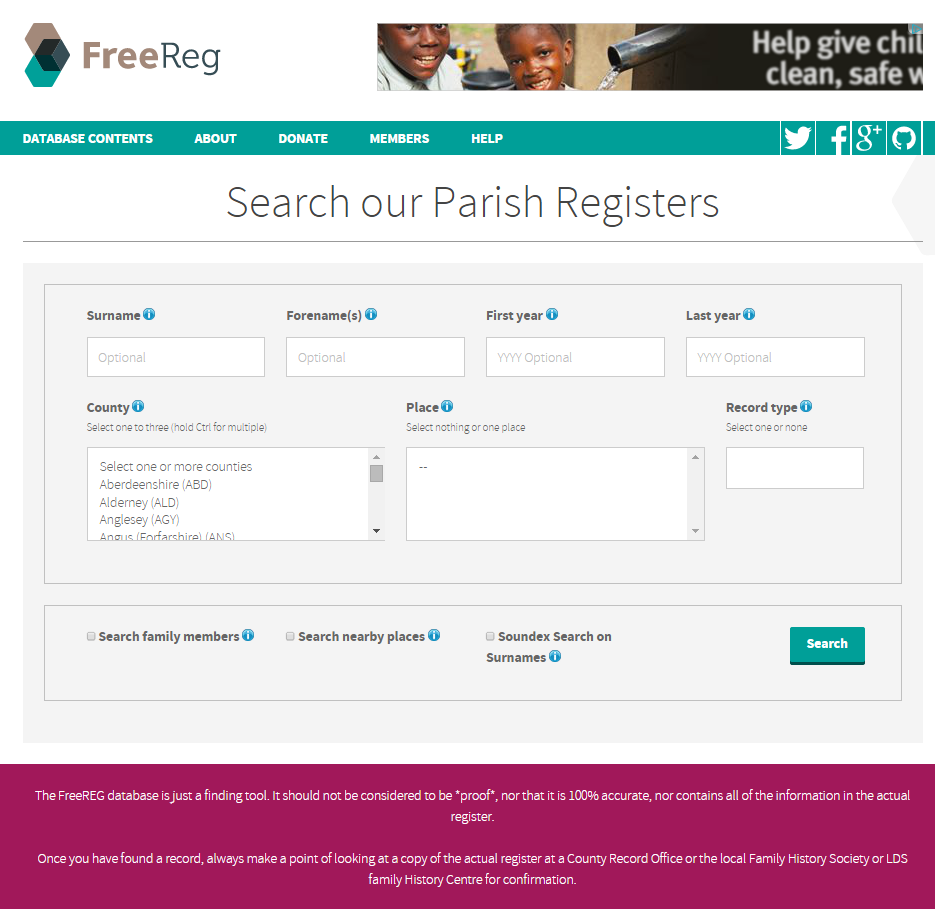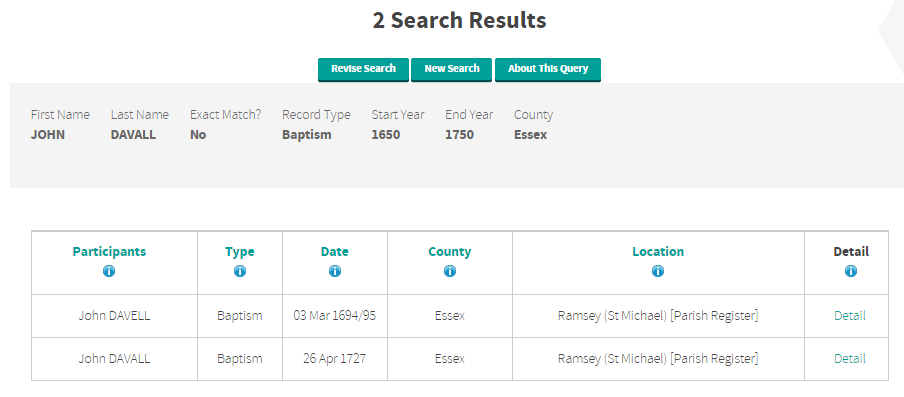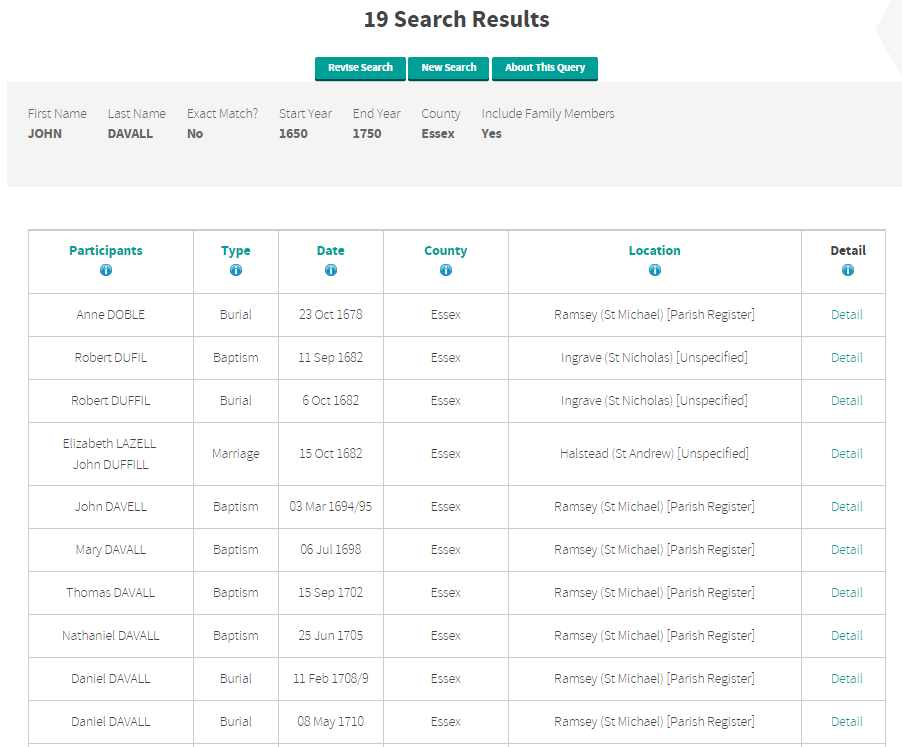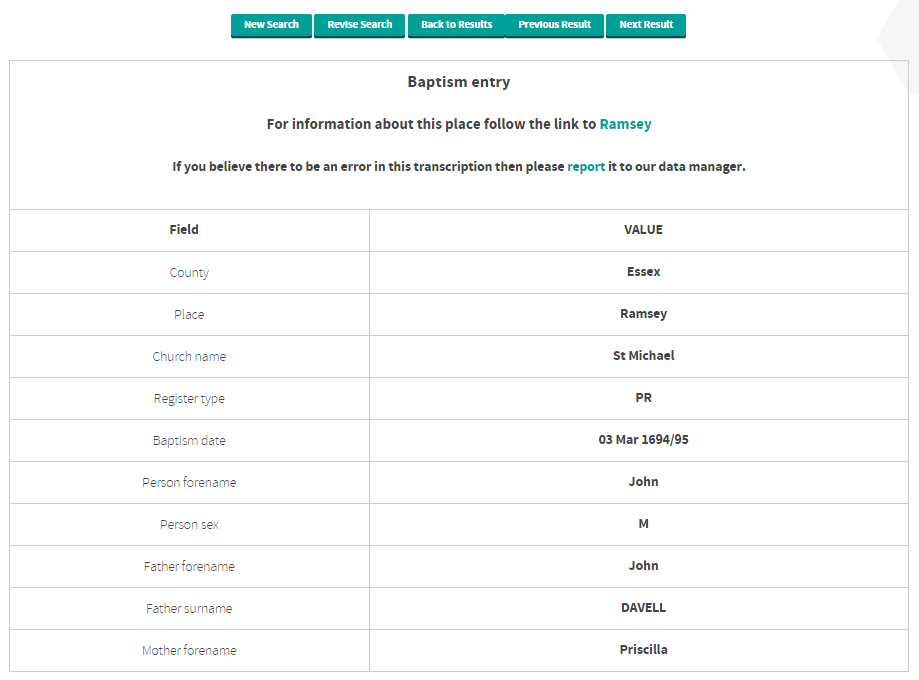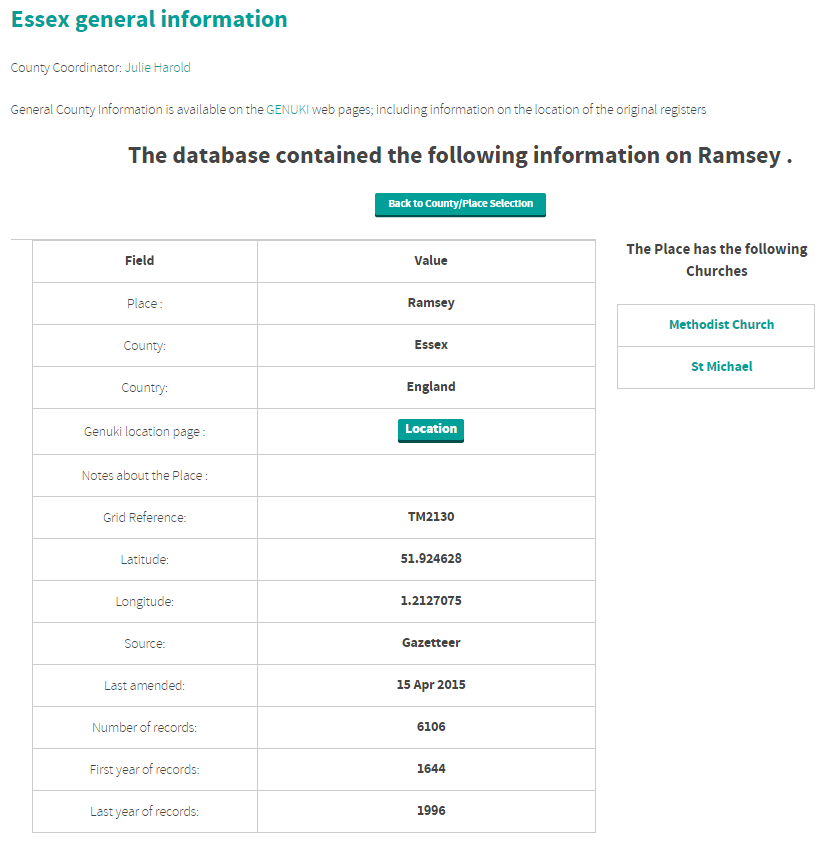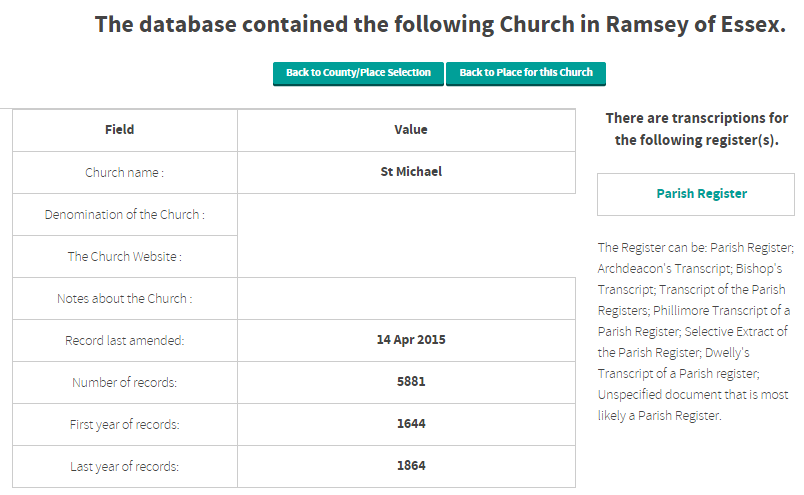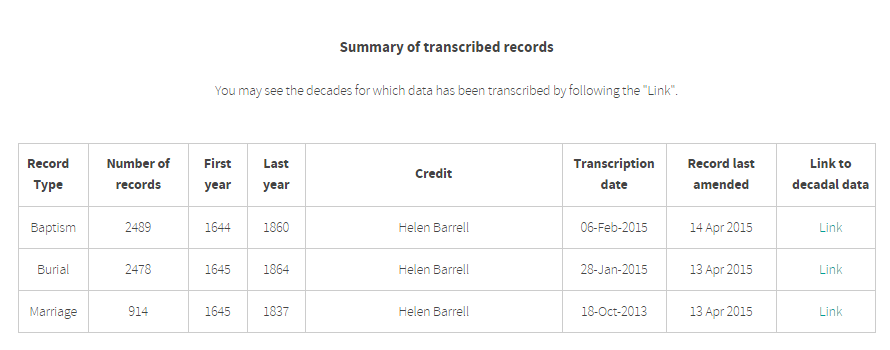After a great deal of work, the new interface for FreeREG is now online: FreeREG2. It sits over a database that contains 20,000,000 parish register transcriptions (and counting) from across the UK. I transcribe for FreeREG (the transcriptions I do are the same ones I put online here) and also use it for my own research, so I’ve been having fun acquainting myself with the new system.
Using the old version of FreeREG (let’s call it FreeREG1), you had to click through two screens to get to the search. You were only able to search baptism, marriage or burial, not all three at once. You had to click county, then if you wanted to search one parish in particular, you had to then scroll through a list of the thousands (it must be somewhere around that number) of parishes to find the one you wanted. Limiting by year wasn’t very flexible as the maximum you could search either side of a given date was 10 years, so people trying to do broader searches across, say, 50 years, had to do multiple searches.
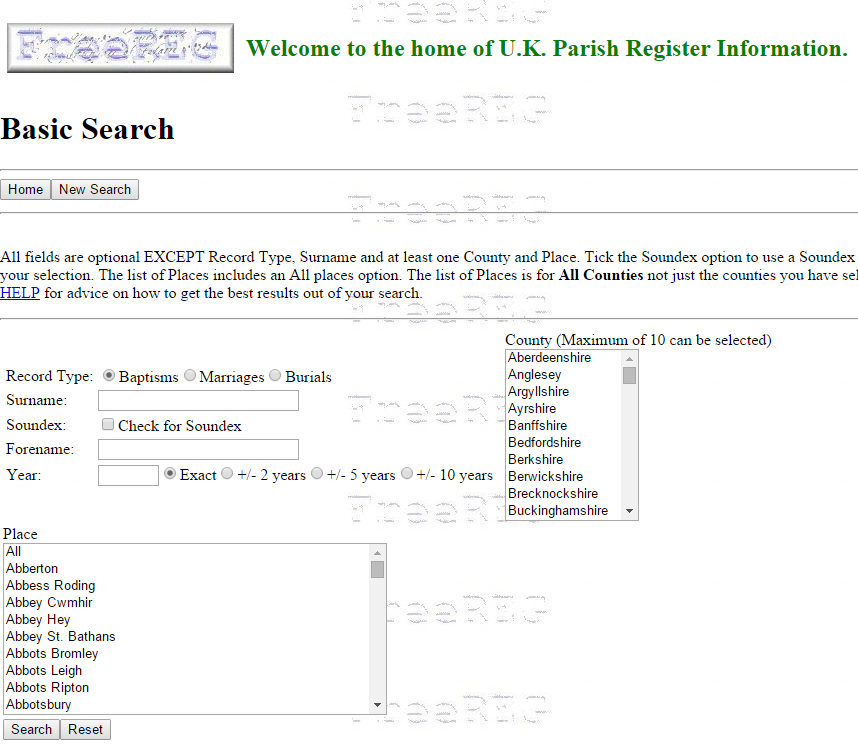
The results weren’t returned in chronological order, but in the order they had been transcribed. So if a transcriber had started with post-1813 registers to get a feel for the names in the area, and then worked backwards, register by register, the results would come up in a strange order. This was particularly frustrating when searching a whole county because of the many different transcribers working on the different parishes. When FreeREG was first launched, this didn’t present much difficulty, but since the number of transcriptions has grown, the interface struggles a bit.
FreeREG2
Perhaps the best way to see what FreeREG2 does is sit down and have a go on it! It does have some nice features that FreeREG1 doesn’t.
You can search using a soundex for surnames, although there isn’t a wildcard, and Latin versions of names should be accommodated automatically. So if you’re looking for “John” and his name was entered in the original register as “Johannes”, it should turn up in your results.
Search across millions of records at once
You can search across all counties in the database – in other word, search across all 20 million records, regardless of location, but you must select a date range and record type. I can see this being extremely helpful for breaking down brickwalls – if someone was baptised outside the county you expected, then a search across all counties’ baptisms (so far transcribed) will now be possible. Bear in mind, though, that the maximum number of results returned is 250.
Include or exclude family members
Before, searching first name and surname would bring up a record which matched because they occurred somewhere in the record (for instance, witnesses at weddings, or it could be the surname of the groom and the first name of the bride’s father), it will now only do this if you tell it to. This narrows it down to just the specific person for whom the record concerns. Below, I searched just for John Davall, baptism, in Essex, from 1650 to 1750, using the soundex. It came up with two results:
But if I do the same search again, having selected “search family members”, I get eight results:
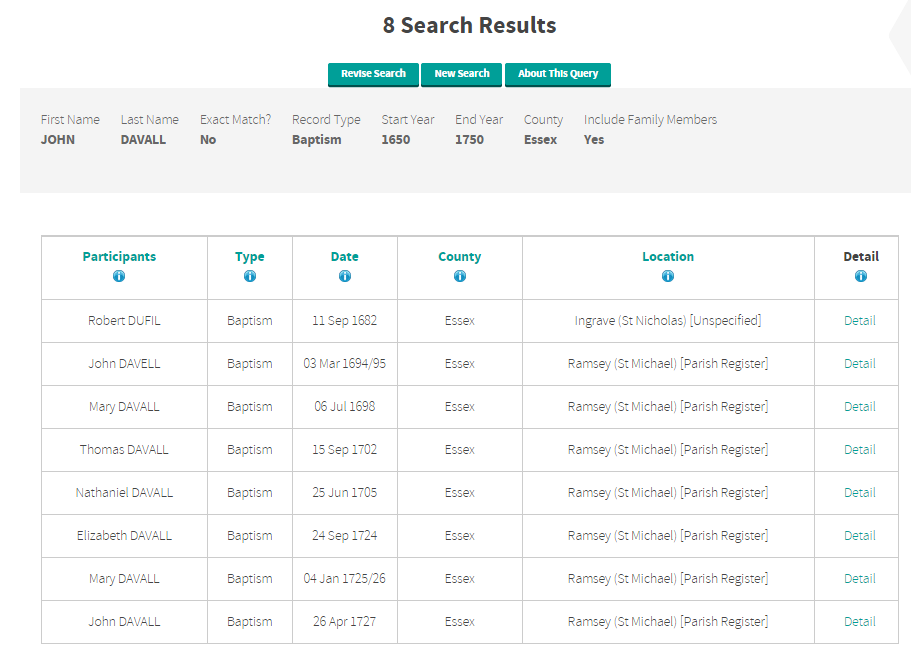 This is a really useful function, which gives you more control over the results you’ll receive. So in this example, if you’re looking for when John Davall was baptised, or if you’re looking for the children of John Davall, you can tailor your search accordingly. It’s helpful if you end up with a parish that has a “serial witness” at weddings. In Wivenhoe, someone called John Barrell (no relation of mine) witnesses dozens of marriages, which makes searching the database for Barrell spouses in Wivenhoe or Essex a right pain. However, avoiding the “search family members” option should exclude them from the results.
This is a really useful function, which gives you more control over the results you’ll receive. So in this example, if you’re looking for when John Davall was baptised, or if you’re looking for the children of John Davall, you can tailor your search accordingly. It’s helpful if you end up with a parish that has a “serial witness” at weddings. In Wivenhoe, someone called John Barrell (no relation of mine) witnesses dozens of marriages, which makes searching the database for Barrell spouses in Wivenhoe or Essex a right pain. However, avoiding the “search family members” option should exclude them from the results.
You’ll also spot that the results now display chronologically by default, which is an improvement on FreeREG1.
Search nearby places
A quick way to catch up with your ancestors as they wander from parish to parish is to use “Search nearby places”. Searching for Nunn, baptisms, and selecting Abberton in Essex, gives me 123 results. This search will include up to forty nearby places, and it tells me that the results are in a radius of 10.2 miles.
Search across all types of records
As mentioned above, you can search across all the records, but as long as you select a time period and a record type. If you select a time period and a county, but don’t select a record type, you will be given results for baptisms, marriages and burials. So if I do the same search as above, without selecting a record type: John Davall, with soundex and family members, in Essex between 1650 to 1750, I get 19 results. The first few are shown here, and you’ll see baptisms, marriages and burials all presented together in chronological order:
Sort your results
You can sort the results further by clicking on “Paricipants”, “Type”, “Date”, “County” and “Location”. Clicking on “Participants” will put it in alphabetically order (by surname); “Type” will sort so that baptisms are followed by burials, and finally marriages; “Date” allows you to sort chronlogically (the default), and “County” and “Location” will put them in alphabetical order by place. This is a welcome improvement, although note that you can only get up to 250 results at a time.
So what happens if you click on “Detail”? This will take you to the full record. So for John Davell’s baptism:
You can travel back and forth through the results using the navigation, and you can find out more information about the parish.
Local information
This will give you place information. Ramsey’s is below:
You’ll see Gazetteer information so that you can find the physical location, but also information on the transcriptions available on FreeREG. So this tells us that the records are available from 1644 to 1996, and that there are 6,106 of them. You can then go further by clicking on the church name.
And if you click on “Parish Register”, you’ll get more detailed information:
Decadal data tells you how many entries, by decade, are available (screenshot not shown). So for instance, Ramsey has 132 baptisms between 1750-1759, but none between 1770-1779 (because I’m still transcribing this parish!). You can also reach this page from the home screen, where it says “Database contents” at the top left. There has been some mention of more precise coverage detail being made available, but I think that’s something for the future.[1]As it is, on Essex & Suffolk Surnames, I give precise info on possible missing years, anomalies, and random things like possible plague outbreaks and visits from Elizabeth I, for each parish and … Continue reading
More updates
You may not know this, but FreeREG1 is manually updated once every 4 weeks. This means there’s a mad dash with transcribers emailing their county co-ordinators to tell them how far they’ve progressed through the records since the last update, so that it appears on the coverage page. FreeREG2, however, automatically updates every night (UK time), so researchers will be getting nice new transcriptions to search every single day.
I think this new interface is great – it makes life easier for researchers as you’ve got more control over your searching and how you sort your results, and it has a clean, unfussy design. No doubt more features will roll out, but for now, I suggest you have a go with it – you never know who you might find.
Footnotes
| ↑1 | As it is, on Essex & Suffolk Surnames, I give precise info on possible missing years, anomalies, and random things like possible plague outbreaks and visits from Elizabeth I, for each parish and update it as and when I find them. |
|---|

